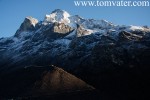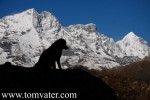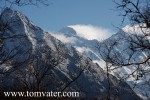In the mid-90s, I trekked around the Everest region of Nepal. Last month I returned, retraced my steps and found both the mountains and myself in good shape. Though a little more torn and frayed than almost 20 years ago. Everything changes quickly, even amongst the world’s highest peaks. And that, apparently, is the way we like it.
Individual walkers like myself have shrunk to a tiny trickle and virtually all foreigners now fly into Lukla airfield to avoid the long, strenuous and hugely rewarding march from Jiri. These first eight days of the trek through the middle hills have changed little (or four if you are Nepali). The locals – Sherpa, Gurung, Rai and other ethnic groups, continue to enjoy exchanges with foreign visitors and derive a very modest income from our presence.
Above Lukla, which receives up to 60 flights a day, it’s a different story. Internet and apple pie all the way. Most tourists walk in large groups, do the entire region in twelve days flat, continually fight with altitude sickness, point their cameras into people’s living rooms and are increasingly seen as a nuisance because the money they spend stays in the pockets of the tour companies. The tourists are older, wealthier, better equipped, blissfully unaware of anything but the scenery. The trails are clogged with German groups, British groups, Australian groups, American groups, Korean groups, Chinese groups, even Iranian groups. Everything is about the shared experience, the noisy column of trekkers trampling up the mountain, scaring animals and people alike out of their way.
One would never guess that there is some kind of recession going on in the West. For better or worse, Everest is booming. But the current upsurge in the region’s popularity and the revolution have had little visible impact in the hills. Poverty in the region remains grinding, despite the fact that visitor figures have more than doubled since my last trip. The Sherpa porters who make it all possible now have mobile phones – my companion and porter for the three week walk, Git Bahadur, remarked drily that next year even the donkeys and yaks would have their own cell phones -while many staff employed by international and local travel agencies go all the way up to Everest Base Camp, where it might snow as late as May, in flip flops.
That said, the mountains remain sublime, bombastic and eternally fascinating and it’s easy to get off the extremely beaten track and suck up the thin air and spectacular, mind-boggling vistas in total solitude.



